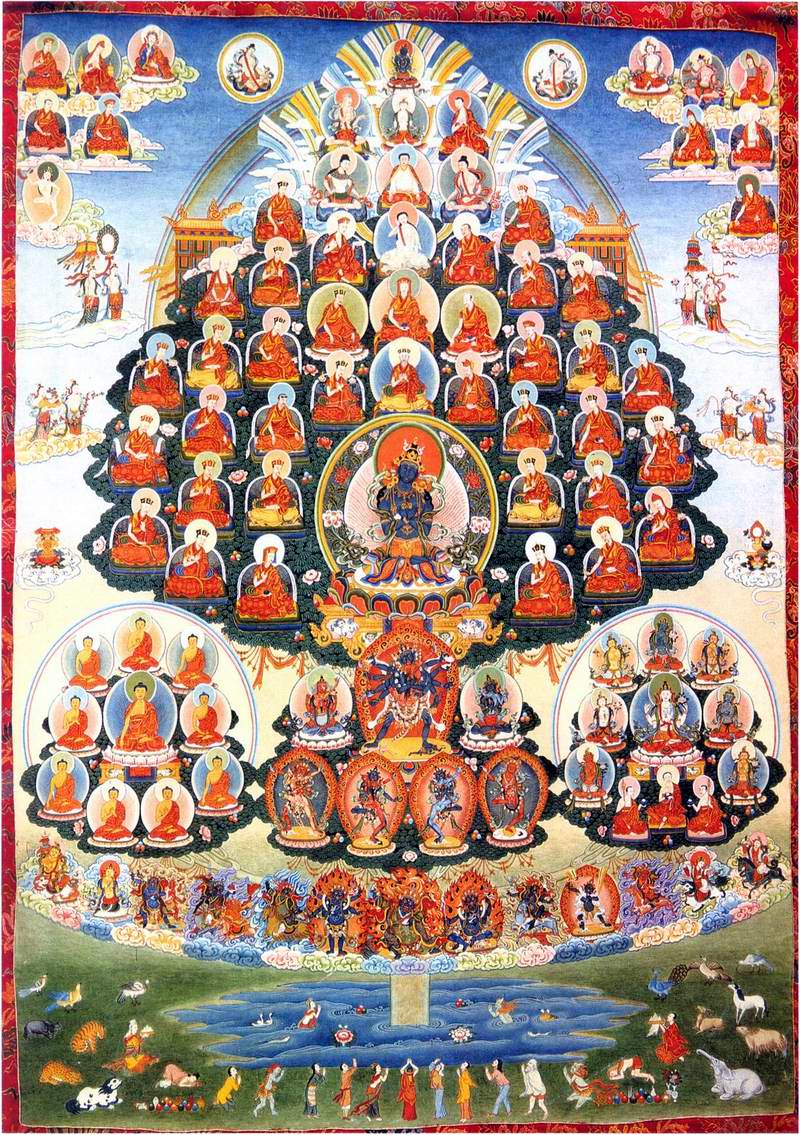guru yoga on:
[Wikipedia]
[Google]
[Amazon]
 In
In
 In
In Vajrayana
Vajrayāna ( sa, वज्रयान, "thunderbolt vehicle", "diamond vehicle", or "indestructible vehicle"), along with Mantrayāna, Guhyamantrayāna, Tantrayāna, Secret Mantra, Tantric Buddhism, and Esoteric Buddhism, are names referring t ...
, guru yoga (Tib: ''bla ma'i rnal 'byor'') is a tantric devotional practice in which the practitioner unites their mindstream
Mindstream (''citta-santāna'') in Buddhist philosophy is the moment-to-moment continuum (Sanskrit: ''saṃtāna'') of sense impressions and mental phenomena, which is also described as continuing from one life to another.
Definition
' (Sanskri ...
with the mindstream of the body, speech, and mind of their guru
Guru ( sa, गुरु, IAST: ''guru;'' Pali'': garu'') is a Sanskrit term for a "mentor, guide, expert, or master" of certain knowledge or field. In pan-Indian traditions, a guru is more than a teacher: traditionally, the guru is a reverential ...
. Guru yoga is akin to deity yoga
The fundamental practice of Vajrayana and Tibetan tantra is deity yoga (''devatayoga''), meditation on a chosen deity or "cherished divinity" (Skt. ''Iṣṭa-devatā,'' Tib. ''yidam''), which involves the recitation of mantras, prayers and vi ...
since the guru (who can be a Buddha, a historical figure like Padmasambhava
Padmasambhava ("Born from a Lotus"), also known as Guru Rinpoche (Precious Guru) and the Lotus from Oḍḍiyāna, was a tantric Buddhist Vajra master from India who may have taught Vajrayana in Tibet (circa 8th – 9th centuries)... According ...
, or a living person) is visualized in the same manner as with a meditational deity. The process of guru yoga may entail visualization of a refuge tree as an invocation of the lineage, with the 'root guru' channeling the blessings of the entire lineage to the practitioner. The guru may be visualized as above the meditator, in front of them, or in their heart. Guru yoga may also include a liturgy, prayer, or ''mantra
A mantra ( Pali: ''manta'') or mantram (मन्त्रम्) is a sacred utterance, a numinous sound, a syllable, word or phonemes, or group of words in Sanskrit, Pali and other languages believed by practitioners to have religious, ...
'', such as the "Seven Line Prayer" of Padmasambhava, or the "Migtsema" (a prayer to Je Tsongkhapa).
Background
As in other Buddhist traditions, an attitude of reverence for the teacher, or guru, is highly prized. A guru or lama is seen as an essential guide duringtantric practice
Tibetan tantric practice, also known as "the practice of secret mantra", and "tantric techniques", refers to the main tantric practices in Tibetan Buddhism. The great Rime scholar Jamgön Kongtrül refers to this as "the Process of Meditation ...
. Without the guru's example, blessings, and guidance, genuine progress in tantra is held to be impossible for all but the most keen and gifted. One particular feature of the Tantric view of teacher student relationship is that in Tibetan Buddhist
Tibetan Buddhism (also referred to as Indo-Tibetan Buddhism, Lamaism, Lamaistic Buddhism, Himalayan Buddhism, and Northern Buddhism) is the form of Buddhism practiced in Tibet and Bhutan, where it is the dominant religion. It is also in majo ...
tantra, one is instructed to regard one's guru as an awakened Buddha.
At the beginning of a public teaching, a lama will do prostration
Prostration is the gesture of placing one's body in a reverentially or submissively prone position. Typically prostration is distinguished from the lesser acts of bowing or kneeling by involving a part of the body above the knee, especiall ...
s to the throne on which he will teach due to its symbolism, or to an image of the Buddha behind that throne, then students will do prostrations to the lama after he is seated. Merit
Merit may refer to:
Religion
* Merit (Christianity)
* Merit (Buddhism)
* Punya (Hinduism)
* Imputed righteousness in Reformed Christianity
Companies and brands
* Merit (cigarette), a brand of cigarettes made by Altria
* Merit Energy Company, ...
accrues when one's interactions with the teacher are imbued with such reverence in the form of guru devotion, a code of practices governing them that derives from Indian sources. By such things as avoiding disturbance to the peace of mind of one's teacher, and wholeheartedly following his prescriptions, much merit accrues and this can significantly help improve one's practice.
See also
*Bhakti yoga
Bhakti yoga ( sa, भक्ति योग), also called Bhakti marga (, literally the path of '' Bhakti''), is a spiritual path or spiritual practice within Hinduism focused on loving devotion towards any personal deity.Karen Pechelis (2014) ...
* Guru in Buddhism
*Mahamudra
Mahāmudrā (Sanskrit: महामुद्रा, , contraction of ) literally means "great seal" or "great imprint" and refers to the fact that "all phenomena inevitably are stamped by the fact of wisdom and emptiness inseparable". Mahāmudr ...
*Samaya
The samaya (, Japanese and , J: ''sanmaya-kai'', C: ''Sān mè yē jiè''), is a set of vows or precepts given to initiates of an esoteric Vajrayana Buddhist order as part of the abhiṣeka (empowerment or initiation) ceremony that creates a bon ...
Notes
References
Citations
Works cited
* * * *Further reading
* {{Buddhism topics Tantric practices Tibetan Buddhist meditation Vajrayana practices